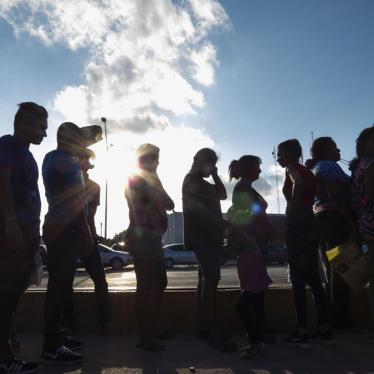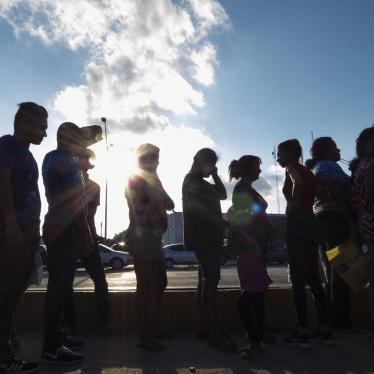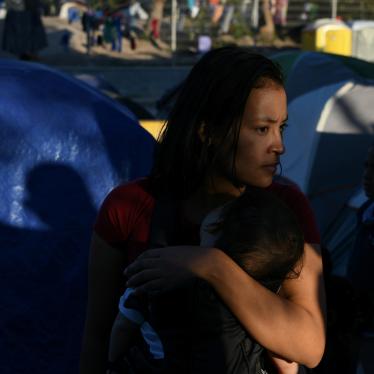On January 25, 2019, the United States Department of Homeland Security (DHS) announced the implementation of the Migrant Protection Protocols (MPP), also known as the “Remain in Mexico” program. The policy allows US border officers to return non-Mexican asylum seekers to dangerous locations in Mexico as their claims are adjudicated in US immigration courts, nearly all without the benefit of legal assistance. As of November 2019, over 56,000 asylum seekers, including 16,000 children (about 500 of whom were under 12 months old), have been sent back to wait in Mexico.
When the policy was announced, then-DHS Secretary Kirstjen Nielsen touted the MPP program as “an unprecedented action” that would “allow more resources to be dedicated to individuals who legitimately qualify for asylum.” On the one-year anniversary of the MPP program, asylum seekers returned to Mexico have instead faced the consequences of a policy that has put tens of thousands of them, including children and families, in harm’s way. The MPP program has also compounded existing failings in US immigration courts, including a lack of access to counsel, barriers to legal representation, lack of transparency in immigration proceedings, and limited legal protections for asylum seekers.
The MPP program has become a fundamental part of the Trump administration’s efforts to eviscerate the US asylum system in contradiction of longstanding US and international refugee law and practice. These deterrence-focused policies include but are not limited to: family separation; narrowed eligibility grounds for asylum; restricted number of asylum seekers allowed into ports of entry each day (“metering”); asylum cooperation agreements through which the United States sends asylum seekers to have their asylum claims examined by third countries; further limitations and fees on the right of asylum seekers to work legally; and proposed fees for applying for asylum.
Asylum seekers swept up in the MPP program face kidnapping, sexual assault, exploitation, lack of basic necessities, abuse and other dangers in Mexico, with no meaningful access to due process in the United States. The sections below address key questions associated with the Trump administration’s “Remain in Mexico” program and immigration courts in the United States.
What is the Trump administration’s MPP or “Remain in Mexico” program?
Who is being placed in the MPP program?
Where is the MPP program in place?
Has the US government evaluated MPP?
What risks do asylum seekers face while waiting in Mexico?
What are conditions like for asylum seekers waiting in Mexico?
What should the US Congress do about the MPP program?
What is the Trump administration’s MPP or “Remain in Mexico” program?
The Trump administration’s Migrant Protection Protocols (MPP) program is a border policy administered by the US Department of Homeland Security (DHS). Under the protocol, asylum seekers who attempt to enter the United States at the US-Mexico border can be sent to Mexico and made to wait there for the duration of their US immigration court proceedings. Once in the MPP, asylum seekers face months or even years in dangerous, destitute, health and life-threatening conditions while awaiting court decisions. Only 4 percent of asylum seekers in MPP succeed in being represented by an attorney. Less than 1 percent have been granted protection in the United States. Some of those who overcame long odds to be recognized as deserving protection in the United States have nonetheless been returned to Mexico again by DHS under the guise of fictitious future hearings for as yet unfiled appeals. The advocacy group Human Rights First has counted at least 816 cases of kidnapping, rape, torture, assault, and other attacks on asylum seekers in the program, including instances documented by Human Rights Watch.
The MPP program conflicts with longstanding US obligations under both national and international refugee law. In 1968, the United States committed to the central guarantees of the 1951 Convention relating to the Status of Refugees (the Refugee Convention) by agreeing to the Refugee Convention’s 1967 Protocol. In 1980, the US Congress enacted the Refugee Act, which brought US law into compliance with the Refugee Convention and 1967 Protocol by incorporating the convention’s definition of refugee and codifying the principle of nonrefoulement, or non-return. This means under the international refugee law refugees cannot be returned to countries where they would likely face persecution.
A DHS memo states that the legal basis for implementing the MPP is section 235(b)(2)(C) of the Immigration and Nationality Act (INA), which “authorizes the Department of Homeland Security to return certain applicants for admission to the contiguous country from which they are arriving on land (whether or not at a designated port of entry), pending removal proceedings under INA §240.”
In April 2019, US District Judge Richard Seeborg in San Francisco issued a preliminary injunction that blocked the program. It said the provisions of the Immigration and Nationality Act that the US government used to institute the program, could not be read to apply to asylum seekers being forced to wait in Mexico. However, in May 2019, the US Court of Appeals for the Ninth Circuit in San Francisco issued a stay that allowed the government to continue to send asylum seekers to Mexico, while the appeal of the preliminary injunction was considered.
As of December 2019, the legality of the MPP program continues to be challenged in a lawsuit led by the ACLU and other immigrant rights organizations. In a separate lawsuit in California, Judge Dana Sabraw ordered DHS to allow asylum seekers claiming fear of return to Mexico access to their own attorneys before they are returned to Mexico under the MPP. The program also faced internal opposition as individual federal asylum officers tasked with carrying out the program and the labor union that represents them have said the program violates the Immigration and Nationality Act. Asylum officers told the media that there were issues with training on the new standards set by the Migrant Protection Protocols during the pilot phase.
Who is being placed in the MPP program?
So far, the asylum seekers being placed in the MPP program are primarily from majority Spanish-speaking countries. A DHS official recently suggested the program could expand to non-Spanish-speaking asylum seekers from Brazil. The Syracuse University Transactional Records Access Clearinghouse (TRAC) published government data indicating that through December 2019, over 59,000 asylum seekers have been returned to Mexico through the program. The top seven national origins of those in the program according to the data published by TRAC are: 21,786 from Honduras; 15,009 from Guatemala; 7,709 from Cuba; 7,668 from El Salvador; 3,114 from Ecuador; 2,046 from Venezuela; and 1,414 from Nicaragua.
A DHS memo exempts Mexican nationals, unaccompanied children, and “individuals from vulnerable populations…on a case-by-case basis.” In practice, exemptions for people with vulnerabilities have been inconsistent as advocates and lawyers have found persons with mental health conditions and LGBT people who were placed in the program and returned to Mexico. According to Mexican government data from June 2019, at least 13 pregnant women were placed in the program–though, in an interview with Public Radio International in December–Al Otro Lado, a legal services provider for asylum seekers, said there are likely dozens of cases of pregnant women in MPP. In August and September 2019, Human Rights Watch researchers interviewed 10 asylum seekers with disabilities or chronic health conditions who faced obstacles to accessing basic services as they were waiting in Mexico.
Where is the MPP program in place?
Then-DHS Secretary Nielsen launched “Remain in Mexico” as a pilot program on January 28, 2019, at the San Ysidro port of entry near San Diego, California and Tijuana, Mexico. The first asylum seeker returned to Mexico was a Honduran man named Carlos Gómez Perdomo who was placed in the program and sent to Tijuana on January 29, 2019. In March 2019, DHS expanded the “Remain in Mexico” program to Calexico, California, across the border from Mexicali, Mexico, as well as to El Paso, Texas, which borders the Mexican city of Ciudad Juárez. This initial expansion occurred despite gathering evidence that the policy had already resulted in harms to asylum seekers and that US border officials were failing to adhere to the basic protections outlined in the initial policy guidelines. In July 2019, the administration expanded the MPP to Laredo and Brownsville, Texas, across from Nuevo Laredo and Matamoros, Mexico, respectively. Both Nuevo Laredo and Matamoros are cities in the Mexican state of Tamaulipas, which is on the US State Department’s “Do Not Travel” list as a result of violent crime and insecurity. In October, DHS announced the program’s expansion to Eagle Pass, Texas, across from Piedras Negras, Coahuila, Mexico. Most recently, in late November and early December, the MPP program was expanded to Tucson and Nogales, Arizona with asylum seekers returned to these cities receiving summonses to appear in court months later in El Paso, Texas.
Has the US government evaluated MPP?
Between the implementation of the pilot phase and the program’s expansion in March, DHS did not release any program evaluation or assessment on the “Remain in Mexico” policy. The rapid expansion of the MPP program occurred amid an internal “Red Team” review of the program ordered by then-acting DHS Secretary Kevin McAleenan and produced by senior DHS officials. The review revealed that under the program, Customs and Border Protection (CBP) agents had pressured asylum officers to deny asylum seekers’ persecution claims during credible or reasonable fear interviews and prevented asylum seekers from accessing asylum officers to consider their claims of fear of return to Mexico. Members of Congress have requested that DHS provide them with the report and recommendations from the review. In mid-January 2020, the House Judiciary Committee opened an investigation into the MPP, asking DHS for documents, data and communications relating to the program.
What risks do asylum seekers face while waiting in Mexico?
Many of the cities that asylum seekers are forced to wait in while in Mexico are dangerous with high risks of kidnapping, extortion, and violence. Some of these cities have recently been or are currently subject to travel advisories by the US Department of State. The State Department has placed the Mexican state of Tamaulipas on its “Do Not Travel” list, saying that US citizens should not travel there due to crime and kidnapping. The Mexican cities of Matamoros, Nuevo Laredo, and Reynosa, all cities where people have been returned under the MPP, are in the state of Tamaulipas. According to a report by Doctors Without Borders (MSF) published in September 2019 that focused on Tamaulipas, “[b]etween June 2018 and July 2019, 45 percent of the 2,315 people (either migrants, asylum seekers, refugees, or returnees) treated by MSF mental health teams in Reynosa and Matamoros reported being victims of violence during their journey through Mexico.” In December, the ACLU and the Center for Gender and Refugee Studies wrote to DHS leadership urging the DHS to end the MPP program in Tamaulipas State, arguing that “implementation of MPP in Tamaulipas–one of the most dangerous regions in the world, and the object of a State Department level four travel advisory–should have never taken place given the country conditions evidence available to DHS.”
Asylum seekers face a multitude of risks waiting in Mexico. Human Rights First has documented “at least 816 publicly reported cases of kidnapping, rape, torture, assault, and other violent attacks against asylum seekers and migrants returned to Mexico.” A study by the US Immigration Policy Center at the University of California at San Diego, surveyed 607 asylum seekers who were subjected to the MPP program and found that about a quarter of them reported being threatened with physical violence while waiting in Mexico, with over half of those threats coming to fruition including beatings, extorsion, kidnappings, and robbery. The study found that the longer respondents waited in Mexico, the more likely they were to be threatened with physical violence before they made it to their court date. Upon release of the study, the lead author and founding director of the US Immigration Policy Center, Tom K. Wong, said that “The Remain in Mexico policy has begged important questions about whether there are sufficient safeguards in place to ensure that the lives and freedom of asylum seekers are not threatened. The data show that there are not sufficient safeguards — lives are literally being put at risk.” The Remain in Mexico program has life and death consequences for asylum seekers who the US government is obligated by law to ensure are not returned to persecution.
What are conditions like for asylum seekers waiting in Mexico?
Activists, advocates, and journalists have documented deplorable conditions for asylum seekers waiting in Mexico. Many asylum seekers have been forced to live in makeshift camps with inadequate access to clean water, showers and bathrooms while they wait for their claims to be adjudicated in the United States. As winter approached, thousands were forced to sleep outside in cold temperatures. According to National Public Radio, over 1,500 asylum seekers are living in one such tent encampment near the Gateway International Bridge in Matamoros, Tamaulipas. The unsanitary living conditions in this encampment and others has left asylum seekers, including small children, vulnerable to the spread of serious illness. Some asylum seekers who fell sick in the camps were blocked by CBP agents from attending their court hearings, as CBP officials are now conducting medical screenings before allowing asylum seekers to cross into the United States. Instead, they were returned once again to Mexico where they often lack adequate medical care, with new, later court dates. Asylum seekers with disabilities have also been denied access to their basic needs such as medication and access to health insurance benefits. Neither the encampments nor many of the migrant shelters meet accessibility standards for persons with disabilities.
What should the US Congress do about the MPP program?
The US Congress should immediately defund and end the MPP program. Congress should enact legislation like Representative Veronica Escobar’s Asylum Seeker Protection Act or alternatively prohibit DHS from using its budget allocation in furtherance of the program. In the short term, Congress should act decisively to expose the program’s abuses through robust, investigatory congressional hearings, briefings, and delegations to border shelters, tent courts, and ports of entry. In the medium- to long-term, the executive and legislative branches of the US government should pass legislation and enact policy to protect the rights of asylum seekers at the border by ensuring they are treated humanely and with dignity and receive fair and timely decisions on their claims.








